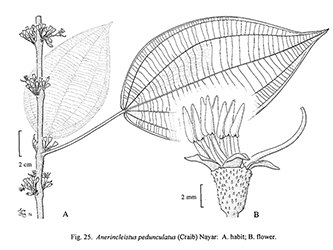e-Flora of Thailand
Volume 7 > Part 3 > Year 2001 > Page 415 > Melastomataceae > Anerincleistus
2. Anerincleistus pedunculatus (Craib) Nayarwfo-0000158728
J. Bombay Nat. Hist. Soc. 72(3): 881. 1976.— Phaulanthus pedunculatus Craib, Bull. Misc. Inform. Kew 1930: 317. 1930; in Fl. Siam. Enum. 1: 688. 1931.
Accepted Name : This is currently accepted.
Synonyms & Citations :
Description : Shrub, to 1 m tall, branchletes terete, young parts covered with appressed setae to 1 mm long. Leaves of a pair usually somewhat unequal, elliptic to ovate-oblong, 6–29 x 3–15 cm, base acute, apex acuminate, margin entire to minutely serrulate, lamina with 1 pair of lateral primary veins plus a faint intramarginal pair, upper surface glabrous except appressed-setose on veins, lower surface more densely setose, petioles 1.5–6.5 cm long. Inflorescences sessile clusters of flowers, on leafless nodes or in leaf axils. Flowers 4-merous; pedicels 7–12 mm long; bracts subulate, minute, caducous. Hypanthium campanulate, 4–8 mm long, appressed setose, often pinkish-red; calyx lobes triangular, 1 mm long, aristate. Petals ca 8 mm long, yellow or white. Stamens 8, subisomorphic, anthers 5.5–6 mm long, yellow. Capsule slightly urceolate, ca 6 mm long, strigose.
Thailand : PENINSULAR: Chumphon (La-un – type of Phaulanthus pedunculatus: Kerr 16491 -BM BK K), Ranong (Larsen et al. 43107), Surat Thani, Phangnga (Kapong – type of P. nervosus: Kerr 17127 -BM BK K), Songkhla (Klawng Yai – type of P. brevidens: Kerr 15888 -BK BM K).
Distribution : Endemic.
Ecology : Evergreen forests.
Notes: Although synonymized under Anerincleistus griffithii by J.F. Maxwell (Proc. Acad. Nat. Sci. Philadelphia 141: 29–72. 1989), A. pedunculatus is distinct from A. griffithii in leaf and stem pubescence and flower size, and the two species are easily distinguished in the herbarium and in the field (S.S. Renner, personal observation, 1992).

